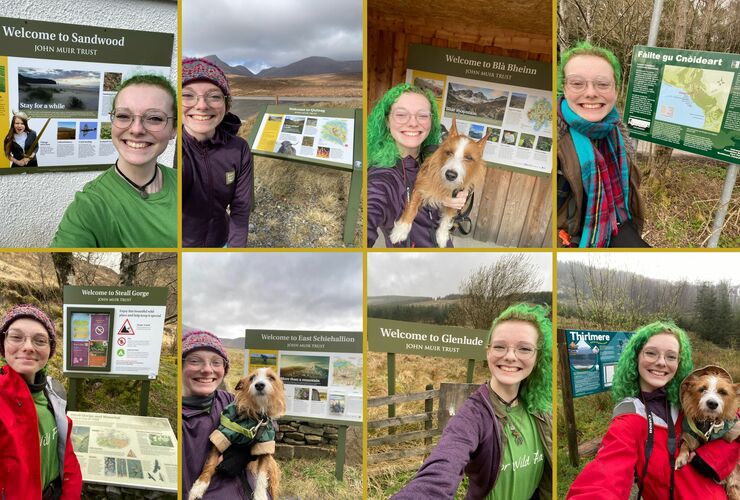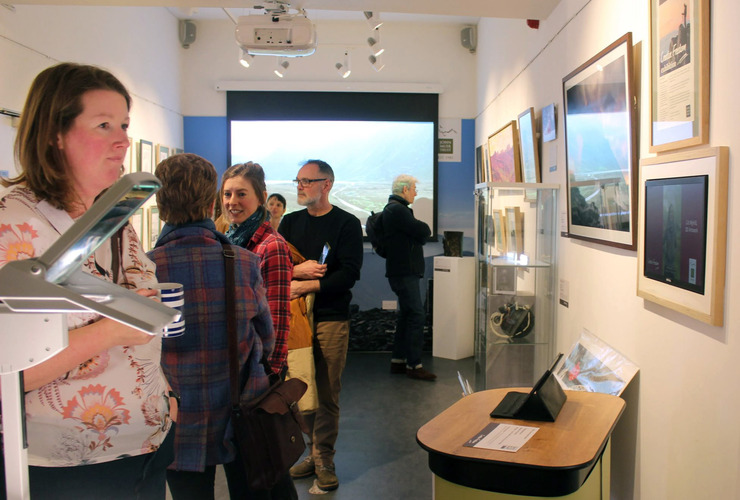Interview: Lizzie Wood
Author and illustrator of Solastalgia, Lizzie Wood, talks to Development and Communications Intern, Heather Graham, about her creative process, her vision for wild places, and what the Creative Freedom exhibition means to her.

Where did the inspiration for your work come from?
In terms of the inspiration, the idea first started pretty organically from that trip that I took down to Glen Feshie, which is where the story starts. I didn't have very many friends at the time because I'd just moved to the area and decided to take myself to a bothy for the weekend just to get outdoors. It was very much based off no expectation to create but just to experience. I didn't expect to have any particularly profound thoughts on the way, but the experience I had when I was in that place provoked me to find out more about the trees that were there and develop that into a story.
The comic format is something that I've picked up over the last couple of years. I first read a non-fiction graphic novel book while studying at university and it opened the door to what comic books and graphic novels could be used for. Since then, I've been playing around with the format and figuring out my own style and process.
What was your creative process?
I don't really have a set creative process per se. This particular piece of work was kind of a one off, a first attempt at creating something like this. I normally start with a lot of research first, then writing the story out, and then the drawing comes at the end. The way I've described it once before to a friend is, after researching and gathering all the components into a big note list of quotes and personal thoughts, I end up with this overwhelming collection of information, like a big pile of clay. Because there is so much going on, I've got to try and sculpt the pieces into something that is nice to look at and is easier to understand. I scoop through all the information and tease the important bits out so I can end up with something that is more coherent that I can then slowly mould it into a more concise script. From that script, I then draw the artwork which I take from sketches I’ve already made from being outside or head back out into nature to absorb more inspiration.
How do wild places influence that creative process for you?
It's not so much that I'm looking to be inspired by natural spaces, but more they surround me, and I am lucky to be in the position where I can visit them often. Wild places naturally inform a lot of my thinking and therefore also impact my creativity. I enjoy being outside - hill walking, climbing, mountaineering, running – anything to be in nature. Therefore, it is an environment that I'm often in contact with and because Scotland has relatively good accessibility across the country, it's quite easy for me to get out into these spaces. Once you have a certain level of transport mobility in terms of maybe owning a car or having some hiking and camping skills, wild places really open up to you and you can explore so much more.
What is the message of your work that you hope people will take away from it?
I think what's quite interesting about this piece is that I never wrote it for an audience. I created this piece as a way of working creatively through some thoughts that I'd had about a particular place. As I’m not a regular practicing artist, I hadn't thought about the way in which it would be viewed by anyone in terms of having a distinct message.
What I’ve appreciated the most from creating this piece is that I’ve had the chance to chat to people who know a lot more about the subject of conservation than me. When I find something out about nature for the first time, it is really mind blowing and exciting, but to some people it’s old news. So I hope that this piece speaks to that beginning point of the learning journey and that people who are a bit more like me, who aren't in that conservation workspace, can learn something new.
In more broader terms, the core message of the piece came from the basic feeling that trees are good - we should look after them, vote for the right people and don't do things that will cause irreversible damage.
What does achieving the top spot in this exhibition mean to you?
It’s been really wonderful and very, very unexpected. I hadn't fully appreciated the format of the exhibition call also having a top selection prize so it was a really lovely surprise, especially as I'm not a full time practising artist. It was always something that I wanted to do more of but didn’t necessarily have the time or inspiration to do. Since the exhibition call, it's something that over the last couple of months I have been able to put more energy towards and having my work externally validated in this way has been really amazing.
When I was creating this piece, I didn’t really know many people in the artistic scene so I didn't have anyone able to give me any feedback or advice - I didn’t have a sense of whether what I was producing was any good. Therefore, the whole experience has been very humbling and it's a pretty big endorsement to have a panel of artist judges say that they think it's good enough to be deemed the top selection and I’ve really enjoyed experiencing the exhibition process for the first time.
Have you got any plans for the residency later in the year?
It would be really nice to write something again using a similar comic format. But they can take quite a long time to produce - it's not the kind of thing that I could necessarily complete in one week.
It would be quite nice to go into this similarly to the first with no expectations to ‘hunt’ for ideas or inspiration, but to have an open mind and let whatever comes come. I always take a sketchbook when I head out into nature so I will definitely be doing that to create some sketches and drawings and paintings from the landscape which hopefully then provide some inspiration for another story. It'd be interesting to chat to some of the local people that live there as well to hear what they have to say in regard to the way the land is managed and how they live in balance with nature.
What does ‘freedom for wild places’ means to you?
There are two sides to my idea of ‘freedom for wild places’. The first is the freedom that we have as people to go into these places and experience them. In Scotland, we're super lucky that we have a lot of freedom in terms of having the right to roam and being able to pretty much go anywhere we like. But there are still a number of barriers to accessing the outdoors: cultural, transport, knowledge, accessibility, skills and equipment are all things that can impact.
The second is the freedom that wild places have from harm. Often, their freedom is restricted by our freedom. A lot of people who take part in activities such as walking, climbing and cycling, also really like nature and want to look after it. However, soil erosion, vegetation destruction and disturbing wildlife are all harmful potential impacts. Even the equipment and the clothing that goes with these activities are often made with chemicals and take lots of energy to produce. People might also go abroad to be in nature which obviously causes a massive carbon output. I don't think people necessarily always appreciate that just because we feel like we're in touch with nature - being outdoors, signing petitions, eating less meat - we are still pretty impactful on the Earth and we need to be more conscious about our choices holistically.
Do you have a wild place that's your favourite?
I don't think I have one particular place. I really enjoy the exploration of nature and I’m still getting to know lots of different places. Maybe if I was able to spend longer in certain areas they would become more of a favourite than others, but I think at the moment there's a lot more to see and a lot more to learn before I could choose.
I come from a small town near Watford in England which was very suburban rural - so while there was still lots of greenery, it definitely didn’t feel very wild. I was also studying in a city during lockdown, so the parks nearby were a huge source of stability during that time. Now that I live in the Scottish Highlands, I really enjoy being a lot closer to wild places.
But I definitely don't think that the word ‘wild’ needs to mean completely isolated. I don't think we have any truly wild places in the UK, even in Scotland. There are lots of hard-to-reach places, but you're never really more than a day's walk from civilisation at any given point.
What do you hope for wild places in the next 40 years?
I hope that more and more people are able to go out and have the experience of connecting to wild places. I don't think that people today will experience the same version of nature that people 40 years ago experienced, or that people in the next 40 years will experience what we do today, but we need people to continue having really powerful experiences when connecting to wild places. Hopefully, in turn, that will show people the value of looking after them and taking a stand for their protection. I am very much someone who believes in humanity and the value of personal experiences and I think most people's lives are made better by having a deep meaningful connection with wild places.
It can be quite difficult to stay optimistic about the future and I do think we need to do more to fight for nature. What we really need is a global change. We've had a lot of impact on wild places. But having an impact isn’t necessarily a bad thing - there's no reason why humans shouldn't impact the landscape so long as it's in proportion and we try limit any negative impacts. We are part of the landscape as well - we are animals and part of nature, so it is impossible not to have any impact at all. But it has to be a balance. Its vital to protect our freedom to explore these places while also protecting wild places themselves.
- See 'Solastalgia' by Lizzie Wood, and all our other favourite submissions, online or in-person in the Wild Space in Pitlochry until June 28th.


